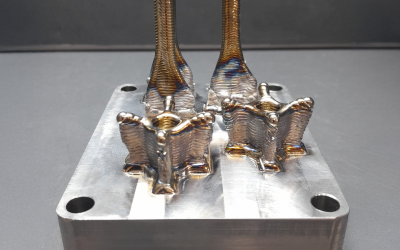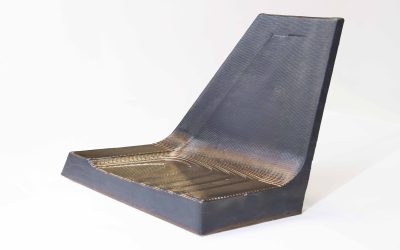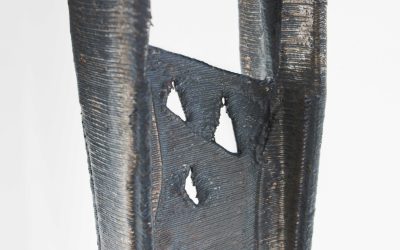Tool steels are key for modern manufacturing: designed to withstand extreme stress, heat, and wear in the most demanding industrial applications. From die casting to injection molding, their properties are critical to productivity and performance. At Meltio, we’re expanding the limits of additive manufacturing by offering a growing list of tool steels that can be reliably printed using our wire-laser metal deposition (LMD) technology.
In this blogpost, we’ll explore our tested materials, including H11, H12, H13, P20, and M7, detailing their mechanical properties, printability, use cases, and heat treatment recommendations to help you select the right solution for your application.
1. Material overview
Tool Steels are either carbon, alloy or high-speed steels, capable of being hardened and tempered; used to manufacture tools, dies and molds that shape, form, and cut other materials.
The martensite content of these steels is crucial for determining their mechanical properties, such as hardness, wear resistance, and impact resistance. Martensite forms through quenching from the austenitic phase, which has a high carbon solubility. Seven main categories can be distinguished.
Our primary and most frequently printed tool steel is H11, classified as a Meltio material, whose datasheet can be found on our website. However, our list of compatible and tested materials also includes H12, H13, H17, P20, and M7.
1. Material overview
Tool Steels are either carbon, alloy or high-speed steels, capable of being hardened and tempered; used to manufacture tools, dies and molds that shape, form, and cut other materials.
The martensite content of these steels is crucial for determining their mechanical properties, such as hardness, wear resistance, and impact resistance. Martensite forms through quenching from the austenitic phase, which has a high carbon solubility. Seven main categories can be distinguished.
| Defining property | AISI-SAE grade | Significant characteristics |
| Water-Hardening | W | |
| Cold-Working | O | Oil-hardening |
| A | Air-hardening; medium alloy | |
| D | High Carbon; high chromium | |
| Shock resisting | S | |
| High speed | T | Tungsten base |
| M | Molybdenum base | |
| Hot-working | H | H1-H19: chromium base H20-H39: tungsten base H4-–H59: molybdenum base |
| Plastic mold | P | |
| Special purpose | L | Low alloy |
| F | Carbon tungsten |
Our primary and most frequently printed tool steel is H11, classified as a Meltio material, whose datasheet can be found on our website. However, our list of compatible and tested materials also includes H12, H13, H17, P20, and M7.
2. Tool Steel H11
Tool Steel H11 is one of the most commonly used tool steels. It is a hot-work steel that is used to make hot-working tools such as forging, die-casting, extrusion, and plastic molds due to its resistance to thermal fatigue cracking and high-temperature abrasion.
This alloy is highly resistant to wear, deformation and heat, which makes it an excellent material for cladding or dual material applications where not the entire component requires these properties. H11 has excellent weldability and can be used to form a dense and well bonded coating layer.
During the 3D printing process, H11 reaches its hardened state. In this state machinability is affected and there is a high risk of cracking due to the reduced ductility. Consequently, a heat-treatment cycle is typically necessary, except for cladding applications or small feature addition, where this hardened state can be beneficial.
The ideal cycle should begin with an annealing step prior to removing the part from the build plate. The material will be softened and free of internal stresses, making it easy to machine. After machining, the part should then undergo hardening and a suitable tempering cycle to achieve the desired hardness.

Although it is not among our fastest-printing materials (150 g/h for blue laser and 141 g/h for infrared laser), it is one of the most market-demanded materials with a high rate of end-user satisfaction regarding the results.
Below, it is provided a series of Reference Standards for this material.
Although it is not among our fastest-printing materials (150 g/h for blue laser and 141 g/h for infrared laser), it is one of the most market-demanded materials with a high rate of end-user satisfaction regarding the results.
Below, it is provided a series of Reference Standards for this material.
| Wrought (ASTM 1472) | Infrared laser | ||
| As printed | Heat treated | ||
| Ultimate Tensile strength [MPa] | 1990 | 1830 | 2087 |
| Ultimate Tensile strength [MPa] | 1650 | 1170 | 1735 |
| Elongation [%] | 10 | 3.46 | 12.18 |
| Hardness [HRC] | 53 | 52 | 51 |
The micrography results were obtained by an external laboratory from a 10x10x60 mm printed block, following ASTM E3-11:2017 standards and ensuring proper preparation and examination of the microstructure.
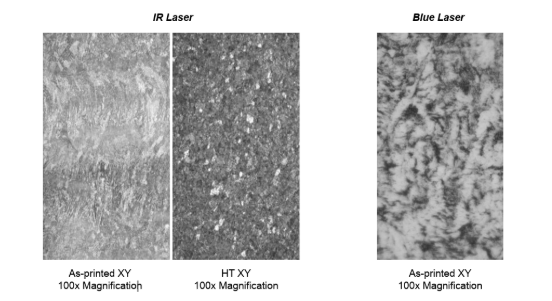
On the other hand, regarding tomography tests, the results of the CT scan of a sample using an infrared laser are attached, showing no detectable voids or defects, with a resolution of 24 μm per pixel.
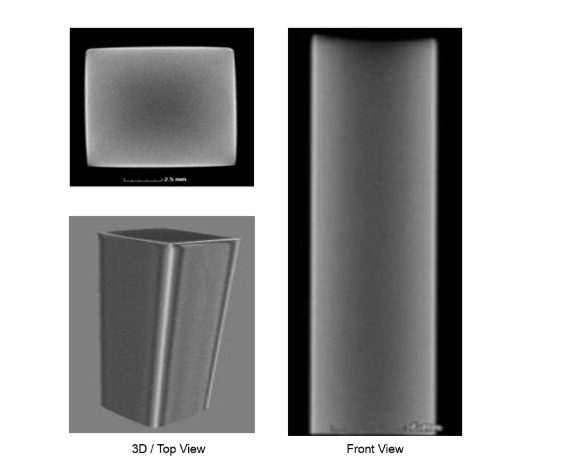
Many market requests originate from customers seeking dual-material prints or reinforcements using this steel. Therefore, understanding the printing behavior of H11 deposited onto a layer of 316 stainless steel is particularly valuable. Elemental (EDX) Mapping is employed to characterize the dilution of the two materials.

Hardness was measured across the material transition and results indicate that a single cladding layer is sufficient to achieve good and stable properties.
This analysis is based on a printed block of 30x60x20 mm using Verified Density Parametrization. A sample from this print was extracted using EDM. The hardness testing was performed in accordance with UNE-EN ISO 6507-1 and was also analyzed by an external laboratory.
One of our application examples is the production of an injection molding insert using H11 tool steel in a single wire configuration. These inserts are typically machined from solid blocks, a process that generates significant material waste and requires long lead times, especially for complex geometries.
With the Meltio LMD process, the insert can be additively manufactured close to its final shape, reducing material usage and machining time. This approach is particularly effective for customized inserts or short production runs, offering greater flexibility without compromising the mechanical performance required for injection molding applications. The picture depicts a machined result already on the build plate.
Hardness was measured across the material transition and results indicate that a single cladding layer is sufficient to achieve good and stable properties.
This analysis is based on a printed block of 30x60x20 mm using Verified Density Parametrization. A sample from this print was extracted using EDM. The hardness testing was performed in accordance with UNE-EN ISO 6507-1 and was also analyzed by an external laboratory.
| Hardness [HV10] | Distance [mm] | Material |
| 670 | 2.1 | Tool Steel H11 |
| 620 | 1.4 | |
| 630 | 0.6 | |
| 440 | 0.0 | Interlayer |
| 200 | -0.7 | Stainless Steel 316-LSi |
| 200 | -1.4 | |
| 200 | -1.8 | |
| 200 | -2.2 | |
| 200 | -3.1 |
One of our application examples is the production of an injection molding insert using H11 tool steel in a single wire configuration. These inserts are typically machined from solid blocks, a process that generates significant material waste and requires long lead times, especially for complex geometries.
With the Meltio LMD process, the insert can be additively manufactured close to its final shape, reducing material usage and machining time. This approach is particularly effective for customized inserts or short production runs, offering greater flexibility without compromising the mechanical performance required for injection molding applications. The picture depicts a machined result already on the build plate.
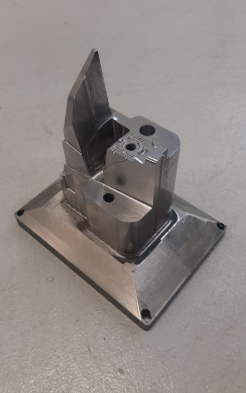
On the other hand, due to growing interest in Meltio technology from the tooling sector, we are currently developing processes for printing this interesting material combination, as you can see in the picture. We have developed geometries made in H11 with integrated cooling channels and inserts in CuCrZr.
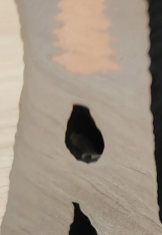
3. Tool Steel H12
Compared to H11, H12 offers better wear resistance and more consistent performance under prolonged high temperature conditions, though it sacrifices some toughness. Its slightly higher carbon content, reduced chromium levels, and the addition of tungsten boost its hardness and thermal stability, making it ideal for applications where resistance to heat and abrasion is more important than impact strength or ductility.
Typical uses include hot forming tools for advanced high-strength steels, molds for glass or heat-resistant plastics, and dies used in sintering or powder metallurgy, any situation where maintaining shape and hardness at high temperatures is critical.
H12 is also a go-to choice for tooling that faces abrasive wear in hot environments, such as extrusion inserts for aggressive alloys or die components used in hot stamping.

4. Tool Steel H13
H13 is one of the most widely used hot-work tool steels, thanks to its well-balanced mix of toughness, resistance to thermal fatigue, and hardness.
Compared to H11 and H12, its higher levels of vanadium and molybdenum give it excellent resistance to thermal shock and better wear performance under repeated heating and cooling cycles. This balance makes H13 especially suitable for tools that face rapid temperature changes and mechanical stress, without sacrificing dimensional stability or lifespan.
It’s also a popular choice for core pins, inserts, and other components that undergo repeated thermal cycling, due to its strong resistance to cracking and heat checking. Thanks to its versatility and reliability under a wide range of thermal and mechanical conditions, H13 has become a go-to material for hot-work tooling around the world.

5. Tool Steel P20
P20 is a pre-hardened tool steel commonly used in plastic injection molding and die casting for low-melting-point alloys. Since it’s delivered already hardened and tempered (typically around 30 and 36 HRC), there’s no need for heat treatment after machining, making the tooling process faster and more straightforward.
Its balanced properties (moderate hardness, good machinability, and decent toughness) make it a great choice for medium to large mold bases and components that don’t require extreme resistance to heat or wear.
P20 is typically used for injection mold cavities, core inserts, die-casting molds for aluminum or zinc, and mold structures where dimensional accuracy and ease of machining matter.
While it’s not ideal for high-temperature or highly abrasive conditions, it performs reliably in general-purpose tooling, offering a practical balance of cost, manufacturability, and mechanical performance.

6. Tool Steel M7
M7 is a high-speed tool steel from the molybdenum-based HSS family. Compared to the more widely used M2, M7 contains more carbon and vanadium, which gives it higher hot hardness and better edge retention. That makes it ideal for high-performance cutting tools where both heat resistance and wear resistance are crucial.
It can hold its hardness even at red-hot temperatures, allowing for high-speed machining without the tool wearing out too quickly.
M7 is often chosen when you need better performance than M2, but don’t want the added cost or brittleness of cobalt-rich steels like M42. Common uses include twist drills, end mills, broaches, reamers, punches, and cold-work tooling that needs high compressive strength and durability.
Like the rest of the HSS family, M7 strikes a good balance between hardness and toughness, so tools can handle both cutting forces and occasional impacts without failing.
7. Why choosing Meltio’s Tool Steel
Material efficiency
Parts can be printed near-net-shape, drastically reducing raw material use.
Tooling components can be printed directly and rapidly,
Multi material
Meltio’s multi-material capabilities allow combining tool steels with other metals.
Complex features such as conformal cooling channels or custom geometries for inserts can be printed directly into the part.
On-demand tooling and repair
Instead of stocking spares or waiting for replacements, companies can print and repair tooling components on-site when needed.
Printed parts, once post-treated, can meet or exceed the mechanical performance of conventionally manufactured tool steels.
With these advantages, additive manufacturing with Meltio is a game-changer for tool steel manufacturing, making the process more efficient and cost-effective.
TIP: Know more about compatible and Meltio materials by downloading the Meltio Materials Printable List.
8. Main applications for Tool Steel
- Tooling and mold-making industry
Meltio’s technology enables rapid production of near-net-shape parts , supports on-demand manufacturing and repair and allows hybrid material solutions.
- Automotive industry
It is used in the manufacture of rapid iteration of forming tools. It also produces materials with excellent thermal fatigue resistance and reduces costs for short production runs or design trials.
- Aerospace industry
Produces high-hardness tools (M7) with excellent edge retention. Supports low-volume, high-performance tooling applications. Enables lightweighting and complex geometry integration.
- Heavy industry
It extends tool life through localized reinforcements and repairs, reduces replacement cycles and cost of large tools, and produces hot-work steels that withstand extreme working conditions.
TIP: Check how Meltio is improving molds with conformal cooling channels.
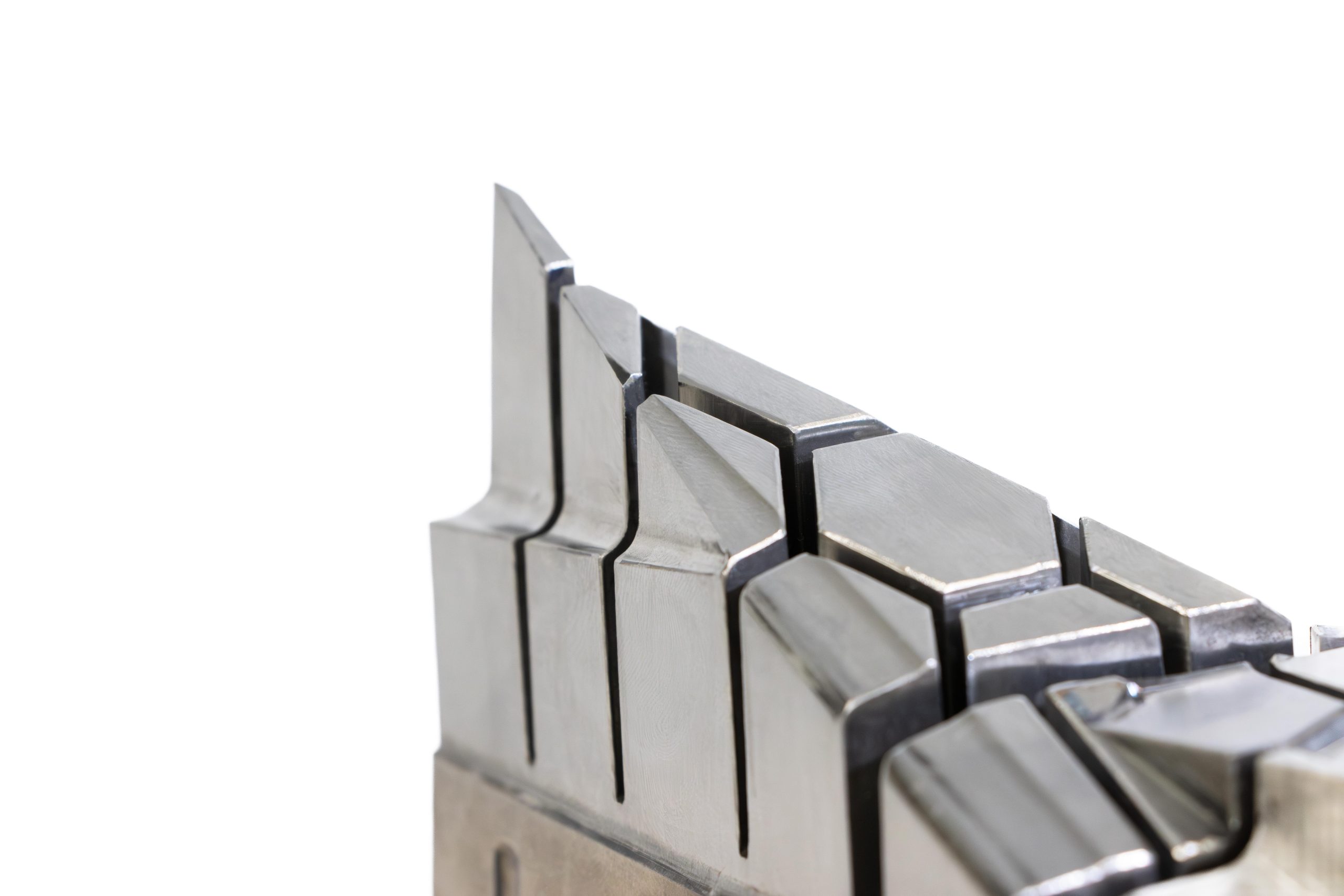
The W-LMD technology produces parts with exceptional microstructure and a density of 99.998%, surpassing the properties of castings and rivaling those of forgings.
9. Advanced manufacturing possibilities with Tool Steels
The ability to print high-performance tool steels with precision and consistency opens new possibilities for manufacturers seeking shorter lead times, material efficiency, and design freedom.
Whether you’re reinforcing parts with H11, printing heat-resistant dies with H12, or optimizing mold inserts with P20, Meltio’s technology enables you to harness the full potential of these alloys. As we continue to test and qualify more materials, our goal is to empower industries with additive solutions that deliver real-world performance and cost savings, without compromising on strength, durability, or flexibility.

